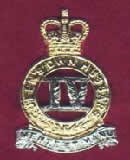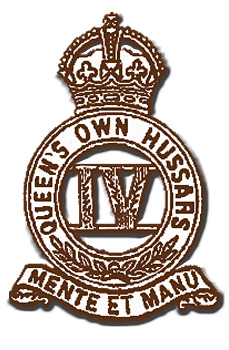
British Hussars (Home) Sword Sales For navigation links to various hussar regiment pages, see below
The
4th (Queen's Own) Hussars |
 |
The Regiment was raised by order of James 1 in 1685, as Princess Anne of Denmark's Regiment of Dragoons, they became known as Colonel Berkeley's Dragoons. By 1742 it was numbered as the 4th and by the Adjutant-Generals of the 23rd June 1788 it was Granted the Royal title of Queens Own, now simply known as the 4th . In 1818 it was again converted, this time to the Light Dragoons and became known as 4th (The Queen's Own) Regiment of Light Dragoons, and in 1861 to Hussars - with the title the 4th Queens Own Hussars. It had the motto "Mente et Manu" granted to it under Army order 157 in 1906.
The Regiment's first offensive actions were in suppressing Jacobite rising and in the Wars of the Spanish and Austrian Successions. At Dettingen, the Regiment (Rich's Dragoons), gained their first Battle Honour. In the Peninsula the 4th Dragoons won six Battle Honours, and after the fall of Napoleon won further distinctions in the Afghan War, they were under the Command of Wellington at the time.
The Regiment took part in the Charge of the Light Brigade. The 4th (Queens Own) Regiment of Light Dragoons silenced the Russian guns, with the support of the 8th King's Royal Irish Hussars. The Regiment also took part in the Battle of Balaclava, it was in this conflict that Private Samuel Parkes of the Regiment was awarded the Victoria Cross for his courageous defence of the Trumpet-Major.
In 1896 a young Winston Churchill joined the Regiment. He became Colonel of the Regiment on22nd October 1941, and remained so until his death.
During World War 1 the 4th Hussars served in France, during these hard times they were and were awarded twenty-one Battle Honours. In 1941 the Regiment took part in the ill-fated defence of Greece, during which it fought a series of rearguard actions covering the withdrawal from the Yugoslav border to the Southern Beaches. Inevitably, in this role, no evacuation was possible. After re-forming in Cairo the Regiment fought in North Africa again and in Italy.

After the Second World War the Regiment spent 1948 - 51 combating terrorism in Malaya, and from 1953 until the 24th October 1958 it was situated in Germany prior to it's amalgamation with the 8th King's Royal Irish Hussars after a magnificent 273 years to form the Queen's Royal Irish Hussars.
Links to other useful sites:
